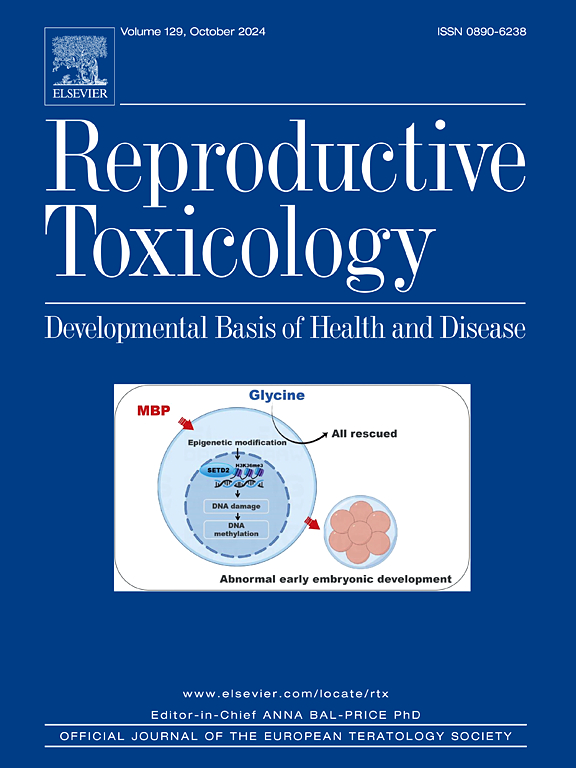发育暴露于环境相关剂量的双酚S损害雌性大鼠出生后生长并破坏胎盘转录谱
IF 3.3
4区 医学
Q2 REPRODUCTIVE BIOLOGY
引用次数: 0
摘要
由于双酚A (BPA)可能对人体健康产生不利影响,而且其普遍存在,因此它正逐渐被双酚S (BPS)等可能更安全的替代品所取代。然而,关于发育暴露于BPS对妊娠和胎儿结局的影响的数据非常少。本研究表明,围产期暴露于极低剂量的BPS会显著损害大鼠的产后生长,并影响胎盘转录组。交配前一周、妊娠期和哺乳期口服极低剂量的BPS(25 ng/kg/天)与产后生长受损有关,雌性妊娠第18天胎儿体重无显著差异。相比之下,在男性中,暴露于BPS 25会在妊娠第18天降低胎儿体重,但生长限制不会持续到成年。在女性中,暴露于这种极低剂量的BPS降低了胎盘中focusyltransferase2 (Fut2)、妊娠特异性糖蛋白22 (Psg22)、Wnt家族成员7b (Wnt7b)的mRNA表达,这些基因与胎盘早期发育有关。类固醇受体共激活因子2 (src2)是类固醇诱导去个体化的关键介质,其胎盘DNA甲基化显著降低,而胎盘src2 mRNA的表达不受影响。这些结果表明,早期暴露于极低剂量的BPS对生长轨迹有长期影响,并与胎盘失调有关。本文章由计算机程序翻译,如有差异,请以英文原文为准。
Developmental exposure to an environmentally relevant dose of Bisphenol S impairs postnatal growth and disrupts placental transcriptional profile in female rat
Because of its possible adverse effects on human health and its ubiquitous nature, Bisphenol A (BPA) is gradually being replaced by presumably safer alternatives like Bisphenol S (BPS). However, data regarding the effects of developmental exposure to BPS on pregnancy and fetal outcomes are very scarce. Here we show that perinatal exposure to BPS at a very low dose significantly impairs postnatal growth and affects the placental transcriptome in rats. Oral exposure one week before mating and during gestation and lactation to a very low dose of BPS (25 ng/kg/day) is associated with impaired postnatal growth without significant difference in fetal weight on gestational day 18 in females. In contrast, in males, exposure to BPS 25 decreased fetal weight on gestational day 18 but growth restriction did not persist into adulthood. In female, exposure to this very low dose of BPS decreased the placental mRNA expression of fucosyltransferase2 (Fut2), pregnancy-specific glycoprotein 22 (Psg22), Wnt family member 7b (Wnt7b) which are involved in early placental development. Placental DNA methylation of steroid receptor coactivator 2 (src2), a key mediator of steroid induced decidualization, was significantly reduced, while placental src2 mRNA expression was unaffected. These results suggest that early exposure to a very low dose of BPS has long term consequences on growth trajectory and is associated with placental dysregulation.
求助全文
通过发布文献求助,成功后即可免费获取论文全文。
去求助
来源期刊

Reproductive toxicology
生物-毒理学
CiteScore
6.50
自引率
3.00%
发文量
131
审稿时长
45 days
期刊介绍:
Drawing from a large number of disciplines, Reproductive Toxicology publishes timely, original research on the influence of chemical and physical agents on reproduction. Written by and for obstetricians, pediatricians, embryologists, teratologists, geneticists, toxicologists, andrologists, and others interested in detecting potential reproductive hazards, the journal is a forum for communication among researchers and practitioners. Articles focus on the application of in vitro, animal and clinical research to the practice of clinical medicine.
All aspects of reproduction are within the scope of Reproductive Toxicology, including the formation and maturation of male and female gametes, sexual function, the events surrounding the fusion of gametes and the development of the fertilized ovum, nourishment and transport of the conceptus within the genital tract, implantation, embryogenesis, intrauterine growth, placentation and placental function, parturition, lactation and neonatal survival. Adverse reproductive effects in males will be considered as significant as adverse effects occurring in females. To provide a balanced presentation of approaches, equal emphasis will be given to clinical and animal or in vitro work. Typical end points that will be studied by contributors include infertility, sexual dysfunction, spontaneous abortion, malformations, abnormal histogenesis, stillbirth, intrauterine growth retardation, prematurity, behavioral abnormalities, and perinatal mortality.
 求助内容:
求助内容: 应助结果提醒方式:
应助结果提醒方式:


